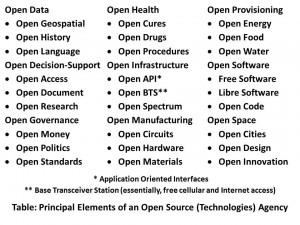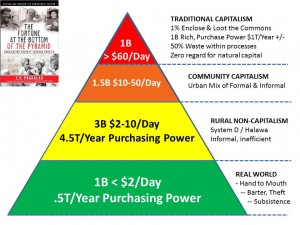
Open Source Everything Engineering (OSEE)
Achieving the SDG Goals in a Fraction of the Time at a Fraction of the Price
Short URL: http://tinyurl.com/SDG-OSEE
Salient Points:
- The Sustainable Development Goals (SDG) are not achievable using the prevailing paradigm of donors, intermediaries, and industrial-era proprietary technologies and costs.
- The SDG goals can be achieved at a one-time cost per person of $500 if the United Nations (UN) will embrace Open Source Everything Engineering (OSEE) as the central method.
- OSEE includes nine major categories – four are known to the UN (Open Data, Open Decision-Support, Open Governance, Open Software), five are largely ignored and their potential not understood (Open Health, Open Infrastructure, Open Manufacturing, Open Provisioning, Open Space).
- An Open Source (Technologies) Agency funded at $2 billion a year by the USA, has been proposed to Vice President Joe Biden and pre-approved in principle by the Office of Management and Budget (OMB) contingent on VP request or Secretary of Defense (SecDef) approval as part of the D3 Innovation Initiative (D3: defense, diplomacy, development).
- A direct inquiry from and engagement by the Secretary General in the very near term could yield an advance on SDG accomplishment unimagined by anyone else.
- More on these salient points, and other related documents charting a path toward achievement of the SDG goals within the decade, is at http://tinyurl.com/Steele-Future.
– – – – – – – – – – – – – – –
The United Nations (UN) could lead and incentivize the achievement of the Sustainable Development Goals (SDG) by and across the five billion poorest in a fraction of the time at a fraction of the cost, if it would embrace the combination of holistic analytics, true cost economics, and Open Source Everything Engineering (OSEE).
Imagine one million Somalis moved from the varied UN camps in Ethiopia, Uganda, and elsewhere, and happily resettled on the northeast coast of Somalia – an uncontested area with nothing more that dirt, seawater, and sunlight – while able to rapidly create a vibrant self-sustaining community with free solar energy, unlimited desalinated water, pressed-brick shelters with compost solutions, free cellular and Internet access, and a thriving aquaponics food industry – all at a one-time cost per person of $500. This is possible. The calculations are online at http://tinyurl.com/500-Civilization. Below is an illustration.

The UN leadership appears unaware of the fact that a new agency, the Open Source (Technologies) Agency, or OSA, has been proposed to the Vice President of the United States of America, and has been pre-approved by the Office of Management and Budget (OMB) at a Final Operating Capability (FOC) budget of $2 billion a year. This agency, inspired by the Secretary of Defense D3 (Defense, Diplomacy, Development) Innovation Summit, would fully fund a D3 Open Source Information Bureau and a D3 Open Source Innovation Bureau. A copy of the Memorandum can be viewed at http://tinyurl.com/VP-OSA.
Were the UN leadership to inquire of the Vice President his views on this new agency, they would discover that the memorandum was not delivered because the staff erroneously concluded that no new agency should be considered this late in the second term. In fact another new agency was just created, to handle security clearances, and there is no better time in modern history for the UN leadership to combine both a new grasp of how OSEE can radically accelerate achievement of the SDGs, and how a direct approach to the Vice President could “free up” $2 billion a year for an OSA with which to achieve the SDG goals quickly and inexpensively.
Among the information-sharing and sense-making elements that the OSA would fully fund for UN coherence and competency are a United Nations Open-Source Decision-Support Information Network (UNODIN), a Multinational Decision-Support Centre, a Global (Serious) Game, a School of Future-Oriented Design & Hybrid Governance, and a World Brain Institute.
Possibilities are illustrated below, drawn from a briefing for the Open Data Institute available at http://tinyurl.com/Steele-Hack. The first features the ten high-level threats to humanity identified by the UN’s own Panel, but ignored by most governments and others. The second shows how the UN could, using UNODIN, finally begin to harness all that is known across the eight information “tribes” – information without boundaries, if you will.


The two graphics in the lower row above depict at the third the four domains that the World Brain Institute could organize, achieving free universal education “one email or cell call at a time;” while at the fourth are the “organs” of a global mind facilitated by the UN – the key is not just data accessibility, but exascale processing, geospatial registry of all data, and true cost economics. More information on these elements can be found at http://tinyurl.com/Steele-Saving.


The innovation divisions – nine of them – would cover the nine major OSEE domains with three local to global project networks within each, as shown below.

The UN leadership should pay special attention, within the above construct devised by Robert David Steele, author of The Open Source Everything Manifesto: Transparency, Truth, & Trust, to Open Health, Open Infrastructure, Open Manufacturing, and Open Provisioning. The advances that can be made in these four areas by the five billion poor are world-changing at speed and at fractional cost.
The rapid prototyping of open source solutions – this is already happening locally around the world – if embraced by the UN and the sharing of knowledge as well as micro-cash payments made to the village level, by-passing the cumbersome, expensive, and often corrupt bureaucracies of the industrial era – would make possible the creation of a prosperous world at peace among the five billion poor, precisely where we need to achieve affordable, inter-operable, and scalable solutions at very low cost. OSEE does this.
Below are two diagrams – on the left, a tiny selection of the existing open source “hacks” that are available for very rapid distribution in the form of knowledge, materials, and seed money; and on the right, the economic triangle with its priorities inverted – the five billion poor are the “green” center of gravity.


The above ideas have been under development for over a quarter century by a diversity of pioneers lacking one thing to go global: UN leadership and the publicity that comes with a blessing from UN leadership.
It should also be possible to engage The Most Holy Father and the Pontifical Academy of Sciences toward a continent-wide pilot program led by the President of Ecuador and the Society of Jesus, offering “liberation technology” to every person in the Southern Hemisphere and then rapidly branching into the Middle East and Central Asia.
It could be that this concept might appeal to the new development authority and new financial authority of the BRICS (Brazil, Russia, India, China, South Africa) as well as Indonesia and Iran. It could and should be offered to Saudi Arabia, Qatar, and the United Arab Emirates as a solution they can implement in Yemen and Somalia.
It is only now, as such distinguished figures as Lady Lynn Rothschild contemplate the need for “Inclusive Capitalism,” that leaders in general are realizing we have failed, and on our present course have limited prospects of achieving the SDG goals prior to a general collapse of politics, economics, and society. The above ideas in combination, at a cost to the US taxpayer of $2 billion a year, but in service to the UN and to all those the UN seeks to help at the bottom of the pyramid, are immediately executable. All the Secretary General has to do is ask.
Robert David Steele
DOC (5 Pages): Open Source Everything Engineering 1.2
Learn more:
The Future: Recent “Core” Work by Robert Steele



